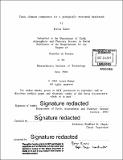Finite element comparison for a geologically motivated benchmark
Author(s)
Peters, Teresa Baker, 1981-
DownloadFull printable version (3.331Mb)
Other Contributors
Massachusetts Institute of Technology. Department of Earth, Atmospheric, and Planetary Sciences.
Advisor
Bradford H. Hager.
Terms of use
Metadata
Show full item recordAbstract
Geologic deformation in three dimensions can be modeled using finite element analysis. In choosing the elements used to solve a model it is important to consider the accuracy of the solution and the computational intensity. The results for models using six element types and six element side lengths are compared for the accuracy of the displacements calculated by the solution and the number of nodes required, as a proxy for computational intensity. Elements that allow higher order solutions are much more accurate than elements that only allow linear interpolation of the stresses and displacements between nodes; however the number of nodes required is five times greater. Free-form meshes do not significantly improve the performance of tetrahedra for the models tested, but could be accurate enough to model curved problem geometries. Comparisons for other models, such as a thrust fault, can be made using a twodimensional simplification of the three-dimensional problem. If three-dimensional comparisons are required it is important to choose a model that has an analytical solution.
Description
Thesis: S.B., Massachusetts Institute of Technology, Department of Earth, Atmospheric, and Planetary Sciences, 2003. Cataloged from PDF version of thesis. Includes bibliographical references (page 22).
Date issued
2003Department
Massachusetts Institute of Technology. Department of Earth, Atmospheric, and Planetary SciencesPublisher
Massachusetts Institute of Technology
Keywords
Earth, Atmospheric, and Planetary Sciences.